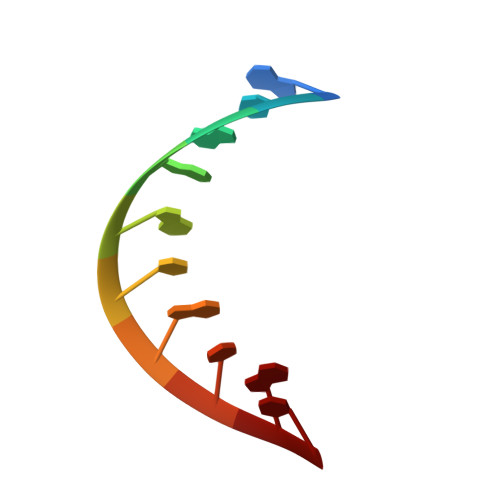NMR structures of r(GCAGGCGUGC)2 and determinants of stability for single guanosine-guanosine base pairs
Burkard, M.E., Turner, D.H.(2000) Biochemistry 39: 11748-11762
- PubMed: 10995243
- DOI: https://doi.org/10.1021/bi000720i
- Primary Citation of Related Structures:
1F5G, 1F5H - PubMed Abstract:
Nucleotides in RNA that are not Watson-Crick-paired form unique structures for recognition or catalysis, but determinants of these structures and their stabilities are poorly understood. A single noncanonical pair of two guanosines (G) is more stable than other noncanonical pairs and can potentially form pairing structures with two hydrogen bonds in four different ways. Here, the energetics and structure of single GG pairs are investigated in several sequence contexts by optical melting and NMR. The data for r(5'GCAGGCGUGC3')(2), in which G4 and G7 are paired, are consistent with a model in which G4 and G7 alternate syn glycosidic conformations in a two-hydrogen-bond pair. The two distinct structures are derived from nuclear Overhauser effect spectroscopic distance restraints coupled with simulated annealing using the AMBER 95 force field. In each structure, the imino and amino protons of the anti G are hydrogen bonded to the O6 and N7 acceptors of the syn G, respectively. An additional hydrogen-bond connects the syn G amino group to the 5' nonbridging pro-R(p) phosphate oxygen. The GG pair fits well into a Watson-Crick helix. In r(5'GCAGGCGUGC3')(2), the G4(anti), G7(syn) structure is preferred over G4(syn), G7(anti). For single GG pairs in other contexts, exchange processes make interpretation of spectra more difficult but the pairs are also G(syn), G(anti). Thermodynamic data for a variety of duplexes containing pairs of G, inosine, and 7-deazaguanosine flanked by GC pairs are consistent with the structural and energetic interpretations for r(5'GCAGGCGUGC3')(2), suggesting similar GG conformations.
Organizational Affiliation:
Department of Chemistry, University of Rochester, Rochester, New York 14627-0216, USA.














